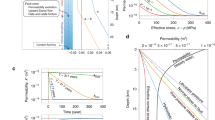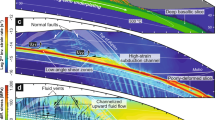Abstract
Subduction megathrust slip speeds range from slow creep at plate convergence rates (centimetres per year) to seismic slip rates (metres per second) in the largest earthquakes on Earth. The deformation mechanisms controlling whether fast slip or slow creep occurs, however, remain unclear. Here, we present evidence that pressure solution creep (fluid-assisted stress driven mass transfer) is an important deformation mechanism in megathrust faults. We quantify megathrust strength using a laboratory-constrained microphysical model for fault friction, involving viscous pressure solution and frictional sliding. We find that at plate-boundary deformation rates, aseismic, frictional–viscous flow is the preferred deformation mechanism at temperatures above 100 °C. The model thus predicts aseismic creep at temperatures much cooler than the onset of crystal plasticity, unless a boundary condition changes. Within this model framework, earthquakes may nucleate when a local increase in strain rate triggers velocity-weakening slip, and we speculate that slip area and event magnitude increase with increasing spacing of strong, topographically derived irregularities in the subduction interface.
This is a preview of subscription content, access via your institution
Access options
Subscribe to this journal
Receive 12 print issues and online access
$259.00 per year
only $21.58 per issue
Buy this article
- Purchase on Springer Link
- Instant access to full article PDF
Prices may be subject to local taxes which are calculated during checkout




Similar content being viewed by others
References
Peng, Z. & Gomberg, J. An integrated perspective of the continuum between earthquakes and slow slip phenomena. Nat. Geosci. 3, 599–607 (2010).
Wang, K. & Bilek, S. L. Do subducting seamounts generate or stop large earthquakes? Geology 39, 819–822 (2011).
Shreve, R. L. & Cloos, M. Dynamics of sediment subduction, mélange formation, and prism accretion. J. Geophys. Res. 91, 10229–10245 (1986).
Bachmann, R. et al. Exposed plate interface in the European Alps reveals fabric styles and gradients related to an ancient seismogenic coupling zone. J. Geophys. Res. 114, B05402 (2009).
Fagereng, Å. & Sibson, R. H. Mélange rheology and seismic style. Geology 38, 751–754 (2010).
Rowe, C. D., Meneghini, F. & Moore, J. C. in Geology of the Earthquake Source: A Volume in Honour of Rick Sibson (eds Fagereng, Å., Toy, V. G. & Rowland, J. V.) 77–95 (Geological Society of London, 2011).
Heuret, A., Lallemand, S., Funiciello, F., Pitomallo, C. & Faccenna, C. Physical characteristics of subduction interface type seismogenic zones revisited. Geochem. Geophys. Geosyst. 12, Q01004 (2011).
Scholz, C. H. & Campos, J. The seismic coupling of subduction zones revisited. J. Geophys. Res. 117, B05310 (2012).
Rubin, A. M., Gillard, D. & Got, J.-L. Streaks of microearthquakes along creeping faults. Nature 400, 635–641 (1999).
Hyndman, R. D., Yamano, M. & Oleskevich, D. A. The seismogenic zone of subduction thrust faults. Isl. Arc 6, 244–260 (1997).
Wallace, L. M. et al. Characterizing the seismogenic zone of a major plate boundary subduction thrust: Hikurangi Margin, New Zealand. Geochem. Geophys. Geosyst. 10, Q10006 (2009).
Mochizuki, K., Yamada, T., Shinohara, M., Yamanaka, Y. & Kanazawa, T. Weak interplate coupling by seamounts and repeating M ∼ 7 earthquakes. Science 321, 1194–1197 (2008).
Power, W., Wallace, L. M., Wang, X. & Reyners, M. Tsunami hazard posed to New Zealand by the Kermadec and Southern New Hebrides subduction margins: an assessment based on plate boundary kinematics, interseismic coupling, and historical seismicity. Pure Appl. Geophys. 169, 1–36 (2012).
Hsu, Y.-J., Yu, S.-B., Song, T.-R. & Bacolcol, T. Plate coupling along the Manila subduction zone between Taiwan and northern Luzon. J. Asian Earth Sci. 51, 98–108 (2012).
Rowe, C. D., Moore, J. C. & Remitti, F. IODP Exp. 343/343T Scientists. The thickness of subduction plate boundary faults from the seafloor into the seismogenic zone. Geology 41, 991–994 (2013).
Gratier, J.-P. et al. Aseismic sliding of active faults by pressure solution creep: evidence from the San Andreas fault observatory at depth. Geology 39, 1131–1134 (2011).
Richard, J., Gratier, J. P., Doan, M.-L., Boullier, A.-M. & Renard, F. Rock and mineral transformations in a fault zone leading to permanent creep: interactions between brittle and viscous mechanisms in the San Andreas Fault. J. Geophys. Res. 119, 8132–8153 (2014).
Gratier, J.-P., Guiguet, R., Renard, F., Jenatton, L. & Bernard, D. A pressure solution creep law for quartz from indentation experiments. J. Geophys. Res. 114, B03403 (2009).
Schwarz, S. & Stöckhert, B. Pressure solution in siliciclastic HP-LT rocks–constraints on the state of stress in deep levels of accretionary complexes. Tectonophysics 255, 203–209 (1996).
Kawabata, K., Tanaka, H. & Kimura, G. Mass transfer and pressure solution in deformed shale of accretionary complex: examples from the Shimanto Belt, southwest Japan. J. Struct. Geol. 29, 697–711 (2007).
Fagereng, Å. in Geology of the Earthquake Source: A Volume in Honour of Rick Sibson (eds Fagereng, Å., Toy, V. G. & Rowland, J. V.) 55–76 (Geological Society of London, 2011).
Fagereng, Å. & Cooper, A. F. The metamorphic history of rocks buried, accreted and exhumed in an accretionary prism: an example from the Otago Schist, New Zealand. J. Metamorph. Geol. 28, 935–954 (2010).
Bos, B. & Spiers, C. J. Frictional-viscous flow of phyllosilicate-bearing fault-rock: microphysical model and implications for crustal strength profiles. J. Geophys. Res. 107, 2028 (2002).
Niemeijer, A. & Spiers, C. J. in High-Strain Zones: Structure and Physical Properties (eds Bruhn, D. & Burlini, L.) 303–327 (Geological Society of London, 2005).
Den Hartog, S. A. M. & Spiers, C. J. A microphysical model for fault gouge friction applied to subduction megathrusts. J. Geophys. Res. 119, 1510–1529 (2014).
Molnar, P. & England, P. Temperatures, heat flux and frictional stress near major thrust faults. J. Geophys. Res. 95, 4833–4856 (1990).
Den Hartog, S. A. M., Saffer, D. M. & Spiers, C. J. The roles of quartz and water in controlling unstable slip in phyllosilicate-rich megathrust fault gouges. Earth Planets Space 66, 78 (2014).
Den Hartog, S. A. M., Niemeijer, A. R. & Spiers, C. J. Friction on subduction megathrust faults: beyond the illite-muscovite transition. Earth Planet. Sci. Lett. 373, 8–19 (2013).
Van Diggelen, E. W. E., De Bresser, J. H. P., Peach, C. J. & Spiers, C. J. High shear strain behaviour of synthetic muscovite fault gouges under hydrothermal conditions. J. Struct. Geol. 32, 1685–1700 (2010).
Den Hartog, S. A. M. & Spiers, C. J. Influence of subduction zone conditions and gouge composition on frictional slip stability of megathrust faults. Tectonophysics 600, 75–90 (2013).
Niemeijer, A. R., Spiers, C. J. & Peach, C. J. Frictional behaviour of simulated quartz fault gouges under hydrothermal conditions: results from ultra-high strain rotary shear experiments. Tectonophysics 460, 288–303 (2008).
Dieterich, J. H. Modeling of rock friction: 1. Experimental results and constitutive equations. J. Geophys. Res. 84, 2161–2168 (1979).
Marone, C. Laboratory-derived friction laws and their application to seismic faulting. Annu. Rev. Earth Planet. Sci. 26, 643–696 (1998).
Scholz, C. H. Earthquakes and friction laws. Nature 391, 37–42 (1998).
Syracuse, E. M., van Keken, P. E. & Abers, G. A. The global range of subduction zone thermal models. Phys. Earth. Planet. Inter. 183, 73–90 (2010).
Gao, X. & Wang, K. Strength of stick-slip and creeping subduction megathrusts from heat flow observations. Science 345, 1038–1041 (2014).
Tester, J. W., Worley, W. G., Robinson, B. A., Grigsby, C. & Feerer, J. L. Correlating quartz dissolution kinetics in pure water from 25 to 625 °C. Geochim. Cosmochim. Acta 58, 2407–2420 (1994).
Hashimoto, Y., Nakaya, T., Ito, M. & Kimura, G. Tectonolithification of sandstone prior to the onset of seismogenic subduction zone: evidence from tectonic mélange of the Shimanto Belt, Japan. Geochem. Geophys. Geosyst. 7, Q06013 (2006).
Moore, J. C., Rowe, C. D. & Meneghini, F. in The Seismogenic Zone of Subduction Thrust Faults (eds Dixon, T. H. & Moore, J. C.) 288–315 (Colombia Univ. Press, 2007).
Wallace, L. M. et al. Slow slip near the trench at the Hikurangi subduction zone, New Zealand. Science 353, 701–704 (2016).
Dragert, H., Wang, K. & James, T. A silent slip event on the deeper Cascadia subduction interface. Science 292, 1525–1528 (2001).
Obara, K., Hirose, H., Yamamizu, F. & Kasahara, K. Episodic slow slip events accompanied by non-volcanic tremors in southwest Japan subduction zone. Geophys. Res. Lett. 31, L23602 (2004).
Liu, Y. & Rice, J. R. Aseismic slip transients emerge spontaneously in three-dimensional rate and state modelling of subduction earthquake sequences. J. Geophys. Res. 110, B08307 (2005).
McCrory, P. A., Hyndman, R. D. & Blair, J. L. Relationship between the Cascadia fore-arc mantle wedge, nonvolcanic tremor, and the downdip limit of seismogenic rupture. Geochem. Geophys. Geosyst. 15, 1071–1095 (2014).
Saffer, D. M. & Wallace, L. M. The frictional, hydrologic, metamorphic and thermal habitat of shallow slow earthquakes. Nat. Geosci. 8, 594–600 (2015).
Ruff, L. Do trench sediments affect great earthquake occurrence in subduction zones? Pure Appl. Geophys. 129, 263–282 (1989).
Wesnousky, S. G. Predicting the endpoints of earthquake ruptures. Nature 444, 358–360 (2006).
Fagereng, Å. Wedge geometry, mechanical strength, and interseismic coupling of the Hikurangi subduction thrust, New Zealand. Tectonophysics 507, 26–30 (2011).
Knipe, R. J. Deformation mechanisms—recognition from natural tectonites. J. Struct. Geol. 11, 127–146 (1989).
Hicks, S. P. et al. The 2010 Mw 8.8 Maule, Chile earthquake: nucleation and rupture propagation controlled by a subducted topographic high. Geophys. Res. Lett. 39, L19308 (2012).
Lamb, S. Shear stresses on megathrusts: implications for mountain building behind subduction zones. J. Geophys. Res. 111, B07401 (2006).
Wada, I., Wang, K., He, J. & Hyndman, R. D. Weakening of the subduction interface and its effects on surface heat flow, slab dehydration, and mantle wedge serpentinization. J. Geophys. Res. 113, B04402 (2008).
McCaffrey, R., Wallace, L. M. & Beavan, J. Slow slip and frictional transition at low temperature at the Hikurangi subduction zone. Nat. Geosci. 1, 316–320 (2008).
Byerlee, J. D. Friction of rocks. Pure Appl. Geophys. 116, 615–626 (1978).
Tembe, S., Lockner, D. A. & Wong, T.-F. Effect of clay content and mineralogy on frictional sliding behaviour of simulated gouges: binary and ternary mixtures of quartz, illite and montmorillonite. J. Geophys. Res. 115, B03416 (2010).
Harris, J. W. & Stocker, H. Handbook of Mathematics and Computational Science (Springer, 1998).
Noda, H. Implementation into earthquake sequence simulations of a rate- and state-dependent friction law incorporating pressure solution creep. Geophys. J. Int. 205, 1108–1125 (2016).
Acknowledgements
Initial work on this project was funded through NRF Incentive Funding for Rated Researchers to Å.F. while at the University of Cape Town. We thank C. Tinguely (Cape Town) and D. Muir (Cardiff) for microprobe/SEM assistance, and A. Cross for a constructive review that significantly improved the manuscript.
Author information
Authors and Affiliations
Contributions
Both authors contributed to designing the study, making the calculations, and writing the paper. Å.F. provided the microstructural observations.
Corresponding author
Ethics declarations
Competing interests
The authors declare no competing financial interests.
Supplementary information
Supplementary Information
Supplementary Information (PDF 3075 kb)
Rights and permissions
About this article
Cite this article
Fagereng, Å., den Hartog, S. Subduction megathrust creep governed by pressure solution and frictional–viscous flow. Nature Geosci 10, 51–57 (2017). https://doi.org/10.1038/ngeo2857
Received:
Accepted:
Published:
Issue Date:
DOI: https://doi.org/10.1038/ngeo2857
This article is cited by
-
Ductile deformation during carbonation of serpentinized peridotite
Nature Communications (2022)
-
Low-effective fault strength of a blind detachment beneath the Indo-Burmese Arc (NE-India) induced by frictional–viscous flow
Journal of Earth System Science (2022)
-
Geological constraints on the mechanisms of slow earthquakes
Nature Reviews Earth & Environment (2021)
-
Microscale cavitation as a mechanism for nucleating earthquakes at the base of the seismogenic zone
Nature Communications (2017)
-
Silica precipitation potentially controls earthquake recurrence in seismogenic zones
Scientific Reports (2017)



